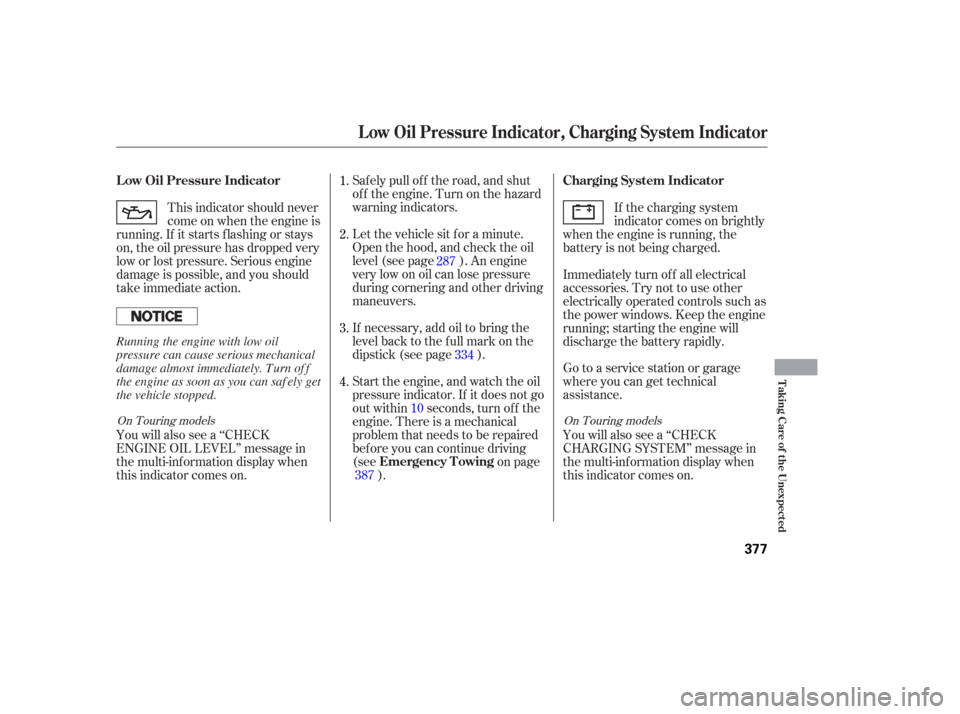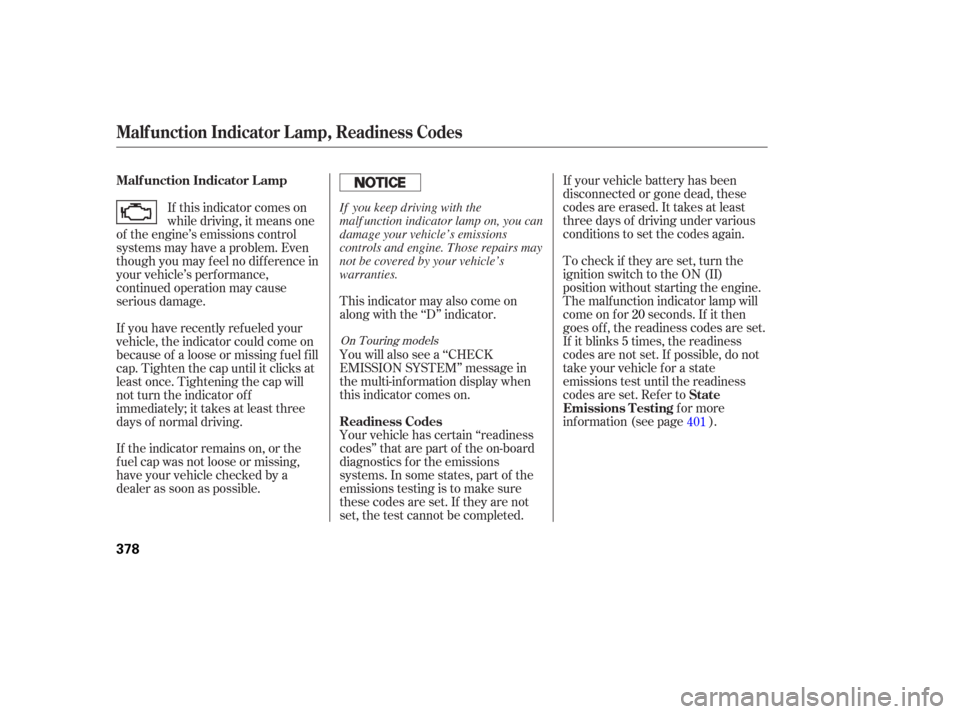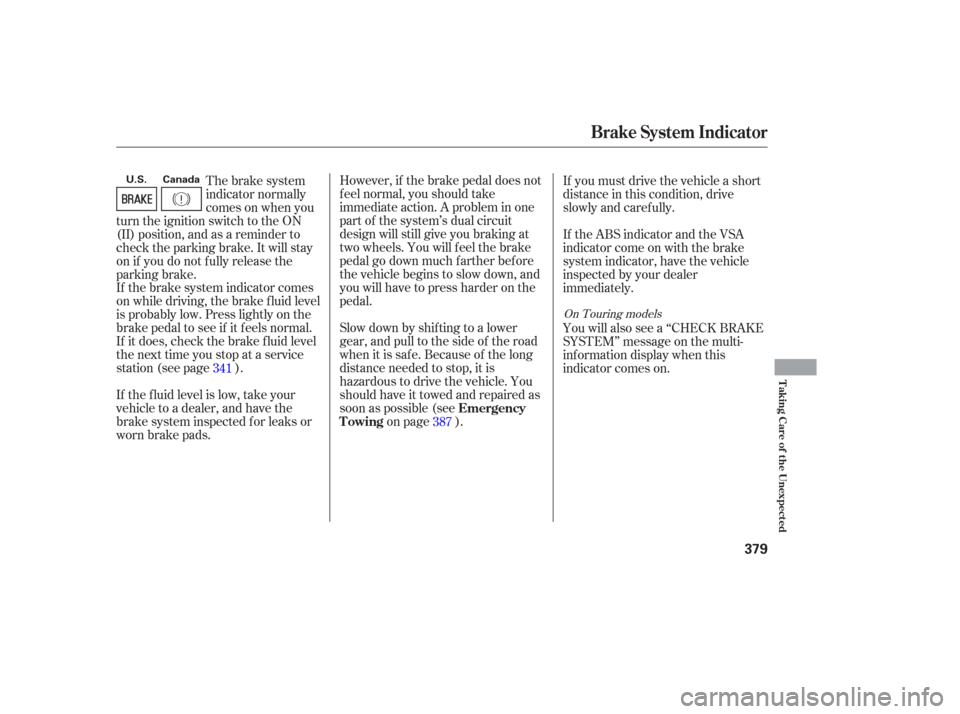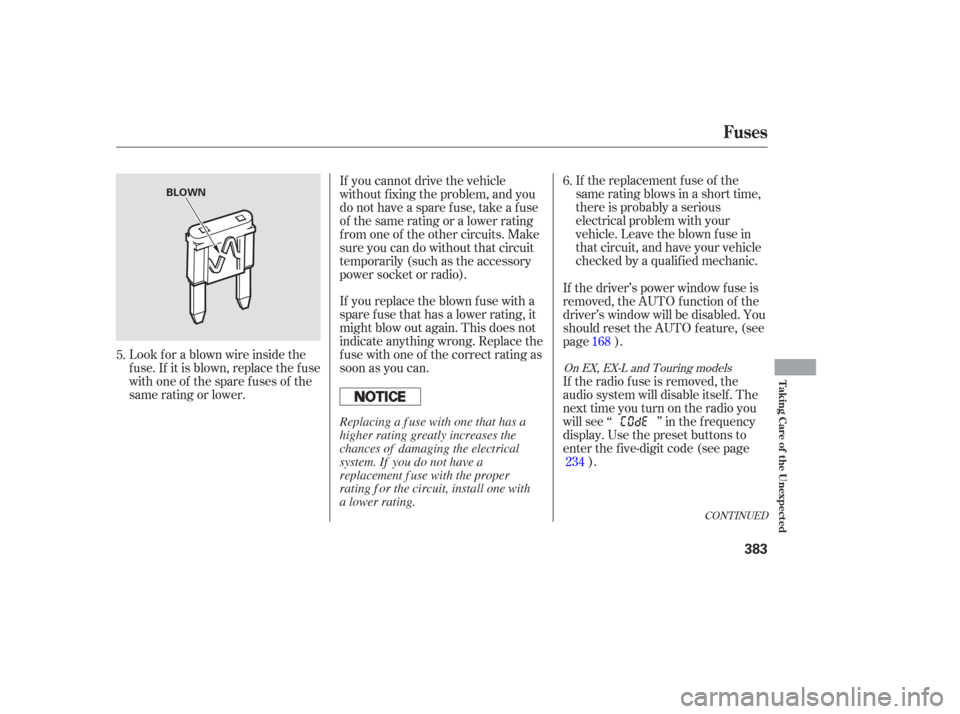2006 HONDA ODYSSEY display
[x] Cancel search: displayPage 378 of 420

Saf ely pull of f the road, and shut
of f the engine. Turn on the hazard
warning indicators.
Let the vehicle sit f or a minute.
Open the hood, and check the oil
level (see page ). An engine
very low on oil can lose pressure
during cornering and other driving
maneuvers.
If necessary, add oil to bring the
level back to the full mark on the
dipstick (see page ).
Start the engine, and watch the oil
pressure indicator. If it does not go
out within10seconds, turn of f the
engine. There is a mechanical
problem that needs to be repaired
bef ore you can continue driving
(see on page
).
You will also see a ‘‘CHECK
ENGINE OIL LEVEL’’ message in
the multi-information display when
this indicator comes on. This indicator should never
come on when the engine is
running. If it starts f lashing or stays
on, the oil pressure has dropped very
low or lost pressure. Serious engine
damage is possible, and you should
take immediate action.
You will also see a ‘‘CHECK
CHARGING SYSTEM’’ message in
the multi-information display when
this indicator comes on. Go to a service station or garage
where you can get technical
assistance. Immediately turn of f all electrical
accessories. Try not to use other
electrically operated controls such as
the power windows. Keep the engine
running; starting the engine will
discharge the battery rapidly.If the charging system
indicator comes on brightly
when the engine is running, the
battery is not being charged.
1.
2.
3.
4. 287
334
387
On Touring models On Touring models
L ow Oil Pressure Indicator
Emergency T owingCharging System Indicator
L ow Oil Pressure Indicator, Charging System Indicator
T aking Care of t he Unexpect ed
377
Running the engine with low oil
pressure can cause serious mechanical
damage almost immediately. Turn of f
the engine as soon as you can saf ely get
the vehicle stopped.
Page 379 of 420

This indicator may also come on
along with the ‘‘D’’ indicator.If your vehicle battery has been
disconnected or gone dead, these
codes are erased. It takes at least
three days of driving under various
conditions to set the codes again.
You will also see a ‘‘CHECK
EMISSION SYSTEM’’ message in
the multi-information display when
this indicator comes on.
Your vehicle has certain ‘‘readiness
codes’’ that are part of the on-board
diagnostics f or the emissions
systems. In some states, part of the
emissions testing is to make sure
these codes are set. If they are not
set, the test cannot be completed. To check if they are set, turn the
ignition switch to the ON (II)
position without starting the engine.
The malf unction indicator lamp will
come on f or
20seconds. If it then
goes of f , the readiness codes are set.
If it blinks 5times, the readiness
codes are not set. If possible, do not
take your vehicle for a state
emissions test until the readiness
codes are set. Ref er to for more
inf ormation (see page ).
If the indicator remains on, or the
f uel cap was not loose or missing,
have your vehicle checked by a
dealer as soon as possible. If this indicator comes on
while driving, it means one
of the engine’s emissions control
systems may have a problem. Even
though you may f eel no dif f erence in
your vehicle’s perf ormance,
continued operation may cause
serious damage.
If you have recently ref ueled your
vehicle, the indicator could come on
because of a loose or missing f uel f ill
cap. Tighten the cap until it clicks at
least once. Tightening the cap will
not turn the indicator of f
immediately; it takes at least three
days of normal driving. 401
On Touring models
Readiness Codes
Malf unction Indicator L amp
State
Emissions T esting
Malf unction Indicator L amp, Readiness Codes
378
If you keep driving with the
malf unction indicator lamp on, you can
damage your vehicle’s emissions
controls and engine. Those repairs may
not be covered by your vehicle’s
warranties.
Page 380 of 420

However, if the brake pedal does not
f eel normal, you should take
immediate action. A problem in one
part of the system’s dual circuit
design will still give you braking at
two wheels. You will f eel the brake
pedal go down much f arther bef ore
the vehicle begins to slow down, and
you will have to press harder on the
pedal.
Slow down by shif ting to a lower
gear, and pull to the side of the road
when it is saf e. Because of the long
distance needed to stop, it is
hazardous to drive the vehicle. You
should have it towed and repaired as
soon as possible (seeon page ). If you must drive the vehicle a short
distance in this condition, drive
slowly and caref ully.
If the brake system indicator comes
on while driving, the brake f luid level
is probably low. Press lightly on the
brake pedal to see if it f eels normal.
If it does, check the brake f luid level
thenexttimeyoustopataservice
station (see page ).
If the f luid level is low, take your
vehicle to a dealer, and have the
brake system inspected f or leaks or
worn brake pads. The brake system
indicator normally
comesonwhenyou
turn the ignition switch to the ON
(II) position, and as a reminder to
check the parking brake. It will stay
on if you do not f ully release the
parking brake. If the ABS indicator and the VSA
indicator come on with the brake
system indicator, have the vehicle
inspected by your dealer
immediately.
You will also see a ‘‘CHECK BRAKE
SYSTEM’’ message on the multi-
inf ormation display when this
indicator comes on.
387
341
On Touring models
Emergency
Towing
Brake System Indicator
T aking Care of t he Unexpect ed
379
U.S. Canada
Page 384 of 420

If the replacement fuse of the
same rating blows in a short time,
there is probably a serious
electrical problem with your
vehicle. Leave the blown fuse in
that circuit, and have your vehicle
checked by a qualif ied mechanic.
If the radio f use is removed, the
audio system will disable itself . The
nexttimeyouturnontheradioyou
will see ‘‘ ’’ in the f requency
display. Use the preset buttons to
enter the f ive-digit code (see page ).
If you cannot drive the vehicle
without f ixing the problem, and you
do not have a spare fuse, take a fuse
of the same rating or a lower rating
f rom one of the other circuits. Make
sureyoucandowithoutthatcircuit
temporarily (such as the accessory
power socket or radio).
If you replace the blown f use with a
spare f use that has a lower rating, it
might blow out again. This does not
indicate anything wrong. Replace the
f use with one of the correct rating as
soon as you can.
Look f or a blown wire inside the
fuse.If itisblown,replacethefuse
withoneof thesparefusesof the
same rating or lower. If the driver’s power window f use is
removed, the AUTO f unction of the
driver’s window will be disabled. You
should reset the AUTO f eature, (see
page ).
5. 6.
168
234
CONT INUED
On EX, EX-L and Touring models
Fuses
T aking Care of t he Unexpect ed
383
BLOWN
Replacing a f use with one that has a
higher rating greatly increases the
chances of damaging the electrical
system. If you do not have a
replacement f use with the proper
rating f or the circuit, install one with
a lower rating.
Page 415 of 420

........................
Low Coolant Level .288
.........................
Low Fuel Indicator .68
...
Low Oil Pressure Indicator .63,377
................................
Lower Anchors .45
..........................
Lower Glove Box .184
...
Lubricant Specif ications Chart .392
...........
Luggage Net (Cargo Net) .295
...........
Luggage, Storing (Cargo) .292
..................................
Maintenance .319
................................
Minder .321-330
.........................
Minder Indicator .70
...
Owner Maintenance Checks .329
.................................
Record .331-332
..........................................
Saf ety .320
.
Malf unction Indicator Lamp .63,378
...................
Manual Sliding Doors .146
...............................
Meters, Gauges .71
..................
Michilen PAX System .362
........................
Mirrors, Adjusting .171
.................................
Modif ications .291
...............
Modif ying Your Vehicle .291
.......................................
Moonroof .170Moving the Second Row Bucket
.............................................
Seat .158
.............
Multi-Inf ormation Display .74
...................
Neutral Gear Position .301
..................
New Vehicle Break-in .284
...................
NOTICE, Explanation of. i
...............
Numbers, Identif ication .390
...
Octane Requirement, Gasoline .284
.........................................
Odometer .72
...............................
Odometer, Trip .72
Oil ........................
Change, How to .335
......................
Change, When to .321
......................
Checking Engine .287
..............
Pressure Indicator .63,377
Selecting Proper Viscosity
......................................
Chart .334
.........
ON (Ignition Key Position) .134
Onboard Ref ueling Vapor
....................................
Recovery .398............................
Outside Mirrors .171
....................
Overheating, Engine .375
.......
Owner Maintenance Checks .329
.........................
Oxygenated Fuels .284
............
Panel Brightness Control .129
........................
Park Gear Position .301
...........................................
Parking .304
...............................
Parking Brake .172
Parking Brake and Brake .................
System Indicator .63,379
...............................
Parking Lights .126
................
Parking Sensor System .277
..
Parking Over Things that Burn .304
....
Passenger Airbag Of f Indicator .33
...................................
PAX System .362
.............................
PGM-FI System .399
........................
Power Door Locks .141
Power Sliding Doors .......................................
Indicator .67
...................................
Operation .146
.....................................
Switches .147
...............
Power Socket Locations .186
..............................
Power Tailgate .143
Index
M N
OP
VI